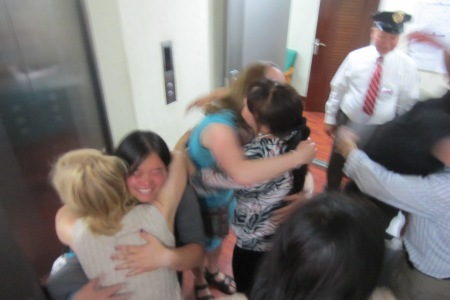A week from today I begin my new job… er, my old job… I’ve been invited back to my old department! While my Europe travel buddies were sending resumes and having Skype interviews, and I was staunchly in vacation mode, this gift of full-time employment (with so many lovely people)–that was difficult to walk away from the first time around–was offered to me anew. So, with a new (old?) gig on the horizon, it’s about time I get this Farewell-to-Peace Corps blog out there.
Leaving Peace Corps
As with leaving any job, leaving Peace Corps involved a series of things that had to be completed and then verified by appropriate personnel: returning our Mongolian IDs, Peace Corps property (water filter, smoke detector), having our passport Visa deactivated, and closing our bank accounts. A few of these would be global Peace Corps requirements (though maybe the type of property to be returned depends on the country of service), whereas others were specific to how things are done in Mongolia (maybe not every country issues an ID). In addition to the final VRF that each of us was required to complete, we also had to write a 2-3 page Description of Service (DOS) which is our official summary of our Peace Corps service. But actually leaving Peace Corps was more than checking these things off the list.
So many goodbyes
To PCVs, who once were spread out across Mongolia and would soon be spread out across America and the globe. I spent many hours in the PCV lounge those last few days of service. Mostly I was using the internet but it put me in a central location for catching up with the others going through the COS Checklist. They’re going off to graduate school, law school, staying for a third year in Mongolia, staying in Mongolia to work outside of Peace Corps, staying in Mongolia to travel, traveling their way home (as I would), living abroad… as many different paths as there are people. We were a solid group, the M23s.
To the wonderful PC/Mongolia staff. That checklist required us to meet with people in many positions, including administrative, general services, medical, programming, and a one-on-one exit interview with the Country Director. During the waiting for signatures, I was lucky that other staff members had time to chat with me. What could have been a very frenetic two days was, instead, a very pleasant series of casual conversations that went beyond goodbye. It was very satisfying to have this downtime. It echoed leaving Govi-Altai and my host family in Orkhon.
The Ringing of the Bell
Following receipt of the final signature on our COS checklist, we were officially done. When we were ready, we took this ceremonial bell into the office of the Administrative Assistant so that she could have it broadcast over the intercom while we rang it. Within a few minutes, the entire staff stopped what they were doing and came to the lobby to say a final goodbye and give a final hug and wishes for safe travels. I don’t believe this is standard operating procedure Peace Corps wide, I think it was adopted from one of the senior staff member’s own country of service. I’ve tried to imagine what ending service would have been like without the ringing of the bell. The words that come to mind are: unfinished, incomplete, anticlimactic, sad. Ringing that bell wasn’t merely symbolic. It was a definitive, tangible moment.
I rang the bell jointly with two people who were important to my Peace Corps service. One was Jason, a site mate of mine during PST. After we each went to our permanent sites, a few times I sent him a card with some Starbucks instant coffee packs that I’d received in a care package. You know how you associate certain people with certain things? Well, for me, Jason = coffee (and running) because our first morning in Mongolia, at the ger camp outside of UB, he shared his coffee with a few of us (after he returned from a run in those sneakers that have toes). Plus, he was in a soum without any sitemates and I was blessed with so many awesome people at my site and we often ate meals together (meals that were enhanced by what was in our care packages)… and, besides, who doesn’t like to receive mail?
The other person was Genni, who I honestly didn’t know well at the time but was about to become my second European travel buddy for three weeks and would therefore forever be inextricably tied to the end of my Peace Corps service. You know how you get a feeling about a person, like you know that the person is really cool and you want to get to know them better, and you’re just waiting for that opportunity to do so to come along? Well, for me, Genni was that kind of person and our Europe trip was that opportunity. So, I was glad that we finished our service nearly simultaneously and were able to ring the bell together, thus kicking off our 3 weeks of bonding.
By the way, I’m pretty sure it is unusual for RPCVs to waltz into a full-fledged career upon return, especially given that many (e.g., those right out of college) have little pre-Peace Corps work experience. So, while I wasn’t looking forward to the job search, and I was counting on my work history to give me an advantage therein, I was expecting to put in the time…believe me, my good fortune is not lost on me!
As I wrote before, I have a few more Mongolia topics in the works so this blog isn’t done yet. To those of you still reading, thanks!





 Posted by eelevol
Posted by eelevol 












